Cuba, Missouri landmark preserved…
The site of historic Wallace House in Cuba, Missouri had a place in history even before the building of the private home of John M. Wallace.
Wallace House at the corner of Smith and W. Washington (old Route 66) was the site of a log fort in 1861. The fort quartered 60 scouts, who engaged in a skirmish with General Joe Shelby of Price’s Army on September 30, 1864. Later, on the site, a man named Peace ran the Pease Hotel. It probably burned in a fire that destroyed many buildings in the business district.
In 1885, John M. Wallace and his wife Virginia bought lots one and two of the block and built a sturdy brick home on the corner of Smith and Washington. Mr. Wallace was a merchant who owned stores in the central area of Cuba. He and his wife were prominent citizens and hosted many entertainments and special events during their day. Ten years later, he moved to Joplin, Missouri.
In the 1920s, the Wallace, daughter also named Virginia, sold lots one and two to the Methodist Episcopal Church. The church added on a sanctuary and bell tower that was joined to the house on the west side. This new configuration was dedicated in 1928. The first floor of the original house was used for Sunday school rooms, and the second floor was the parsonage. Joyce Stewart’s grandparents Jake and Florence Dorf were in the congregation that purchased Wallace House to use as a church, and her grandfather purchased the old church to use as his hardware store.

The Methodist Church of Cuba bought Wallace House in 1928 and originally owned the entire block where it is located.

The Methodist’s women’s group was an important force in the church. They were probably some of the staunch believers that kept their church alive during tough times.
Although the church was growing in 1928, the Depression in 1929 brought tough times to the town and the church. Church records show offerings on June 20, 1937 of $1.61 and on June 27 of $1.62. In January 1938, the church had only 37 cents in the treasury to begin the new year. The district superintendent encouraged the church to close, but the Methodists refused to give up on their church. They didn’t have money, but they did have extra land in the center of Cuba. The church sold off a portion of its land to the Roberts-Judson Lumber Company and was able to continue.
In 1940, church history and United States’ history coincided when Harry S. Truman came to town when he was running for the senate. Truman stopped along the busy Route 66 and stood on the steps of the Methodist Church perched on a Coca-Cola box to speak. However, the citizens passed by without stopping. Truman asked two local Democratic workers Frank Askins Sr. and Harvey Taff, why no one was stopping. They told him that everyone was going to the Homecoming, which was what the Cuba Fair was called then. Truman was reported as having said that he would go to the fair too, so he took his Coca-Cola box and moved on to the fair to make his speech. Local legend has it that he had to pass the hat for campaign money to get to the next town on his stop.
It is this scene that Viva Cuba commemorated in the mural on the Roberts-Judson building next to the property today. The scene also highlights 4-H cattle as the 4-H organization was 100 years-old when the mural was painted, and this organization has been important to the rural children around Cuba.
Although the Methodists loved their historic church, growing numbers forced them to build a new church farther up W. Washington/Route 66 and to sell the building that they loved. The old bell tower atop the worship hall was removed as it had developed termite problems. David and Chili Workman were contracted to build the new church in 1981 and later the new parsonage that sat nearby. The church arranged for the stained glass windows in the historic building to be removed and installed in the new church.
When the church moved to its new building, five couples banded together to buy the old church and remodel it as an office building: Charles and Wanda Kolb, Art and Willa Gross, Norman and Betty DeLeo, Bob and Joyce Stewart, and Marilyn and Bob Wilson. Then as Hwy. 19 was developing, and the commercial area seemed to shift, the building was again put up for sale. For a time, it looked as if they were going to have to sell it to Roberts-Judson and Mace Grocery to be torn down for use as a parking lot.
Joyce Stewart, who had been married in the church said, “Both of my boys were raised in the church, with my aunt Rose Wiggins Smith as their Sunday School teacher. I was a Sunday school teacher there too, and one Halloween, my high school class students transformed the attic and dirt floor basement into a “haunted house” that was very successful.”
With memories like that, they couldn’t bear to see the old church and historic building torn down. Joyce’s son Roger Stewart was upset by this development and contacted his cousin David Workman and asked him to see if the builidng was worth renovating. David, a building contractor and lover of old buildings, was interested in taking on the project. The building seemed to have the proverbial nine lives.
In the 1993 to save the building from being torn down, several couples banded together to buy it, A decision was made to call it Wallace House as it had been originally. Under David Workman’s direction and supervision of his building crew, the building was returned to its previous glory as a private residence and is rented to people to host special events in their life such as showers, anniversaries, special dinners, and sometimes for small retreats or conferences. The owners, serving tasty homemade food, are caterers and servers for the events.
The ownership shifted a little over the years, but Wallace House is now owned by Judy and David Workman, Dave and Tricia Workman, Chili and Frieda Workman, and Bob and Joyce Stewart.
Today, the interior is beautifully restored. The downstairs of the house has a formal parlor, two large open rooms that adjoin,rest rooms, and a kitchen, and hallway with stairs to the upper floor. Most of the furnishings are family pieces, except for an antique organ donated by Jeff Bouse, and an antique oil lamp donated by Audrey Hayes. A large antique serving table works beautifully for buffets. Upstairs, there are three bedrooms decorated in antiques and two modern bathrooms. The upstairs rooms are not rented out, but sometimes used by family members of the owners. The original-style front porch has been added back to the house. Local photographers use Wallace House as a backdrop for photos, and tourists often stop by to photograph the mural and Wallace House.
Wallace House has survived, and thanks to some Cuba citizens who value its history, is preserved for future generations and, just as it did when the Wallace’s lived there in the 1800s, social events take place and laughter reverberates in the historic building. Joyce and Bob Stewart were able to celebrate their 50th Anniversary in the building that meant so much to their family and others. Wallace House is a building with soul that has a legacy that continues for a new generation.
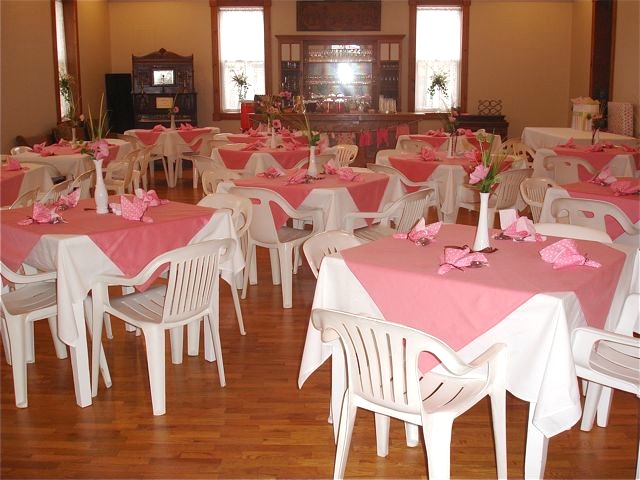
Today, the Wallace House and former Methodist Church has been restored and is rented for special events such as this baby shower.
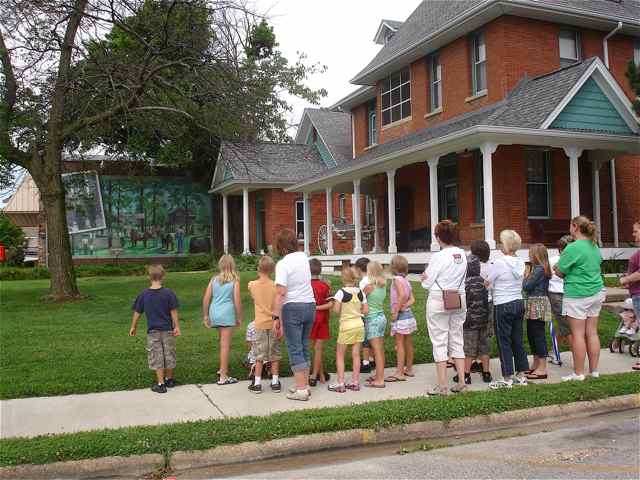
Viva Cuba leads a group of children on a tour of the murals. A new generation is learning the history of Wallace House, Harry Truman, and the old Methodist Church.

Tourists come on motorcycles and in cars to photograph the Truman Mural and Wallace House. Some of the cars are classics like those seen here..
To rent the public rooms of Wallace House, you can contact Joyce Stewart or Judy Workman.
To learn more about the history of the Methodist Church in Cuba visit the history section of the church’s website.




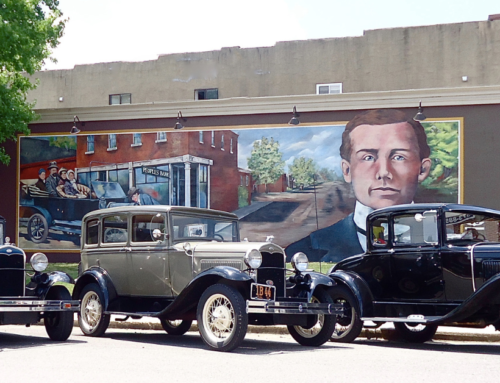

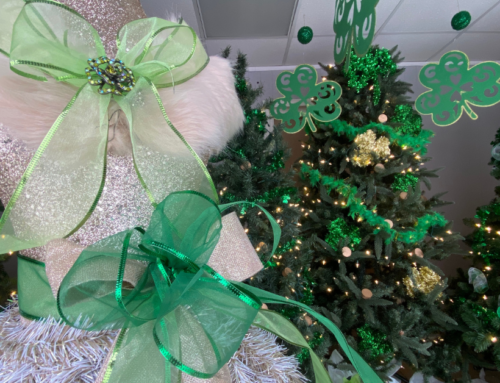

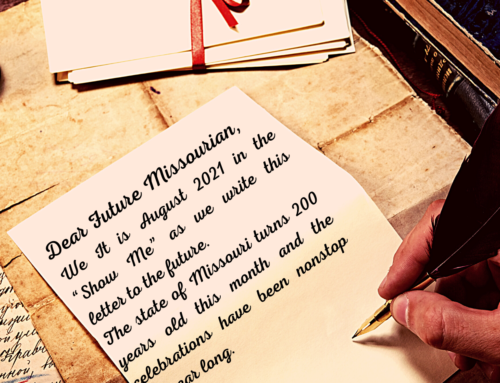
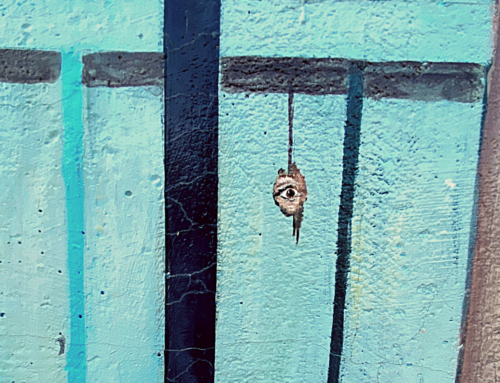
A few years ago, I was in contact with Dale Richardson of Cuba about a bell cast by my great-grandfather, David Caughlan. It was originally in a Methodist church in Cuba, I believe.
I wonder if it could now be connected with either Wallace House or the present school system. The bell, about 17″ at the mouth, would have his name cast into it, along with “Saint Louis Mo.”
I look forward to hearing from you, email:
Mary
We’ll see if we can’t get a little information on this for you.
ONe of the Methodists who grew up in the church said that when the church moved from Wallace House that there was an agreement to move the bell to the new Methodist Church down the street and use it.
Today, March 11, someone from the church went into the attic to the old bell. The bell is in the church steeple, and it is hard to see all the writing on the bell. What could be seen said “M. Rumsey MFG. Com St. Louis, MO 1886.” Do you think that this is your bell?
An invitation to a birthday party at the Wallace House led me to this site. I had never before been there(Wallace House) and knew nothing about it, never even hear of it. I am very impressed with your presentation of the attributes of Cuba and also the complimentary lead-in to Steelville. GREAT WORK.
Thank you. Hope you have a great time at Wallace House. It’s a beautiful building. I have been to all kinds of events there, and it’s great. People always seem to have a good time.
There have been weddings at Wallace House. Of course, it depends on you how many you are inviting.
Actually, the hotel was Pease Hotel.
Thanks, Marilyn. I have it corrected.
What number would I call to rent? I am very interested in renting the Wallace House for a Mary Kay massage party.
Judy Workman’s numbers are the following:
573-885-2775 or 573-259-0169
I recently had my wedding at this location, 11-8-13, and it was Beautiful! Thank you so much Judy! Everything was wonderful and I am thankful that you saved this house because now it has twice as much meaning and beauty for us!
The four couples that have restored and manage this community treasure have done a wonderful thing for our town. It is good to know that a new generation is still enjoying this landmark.
Hello..I have been searching cuba mo for a nice place for giving a baby shower..this popped up and I would love to have more info. Price..Pics..etc
I am looking for something reasonable. Thx for your time and I look forward to hearing from you.
Wallace House has a Facebook page, and you can message the owners there for more complete information.
Love the pumpkins and the old stove at Frisco #39;s Grill amp; Pub in Cuba, MO. The eatery passed out treats to area kids. Love the pumpkins and the old stove at Frisco’s Grill Pub in Cuba, MO. The eatery passed out treats to area kids.